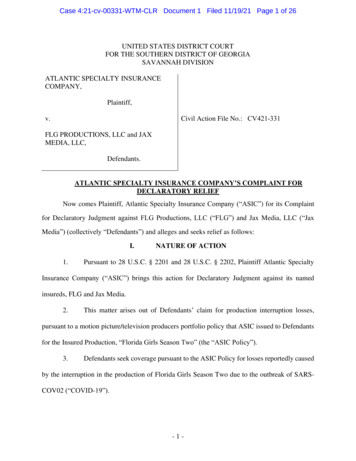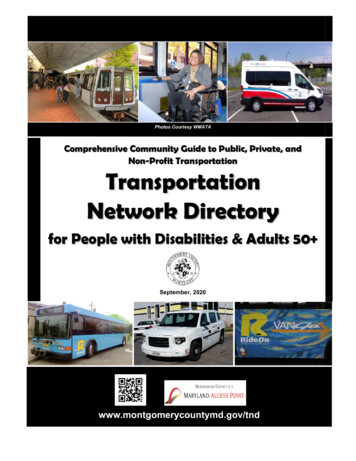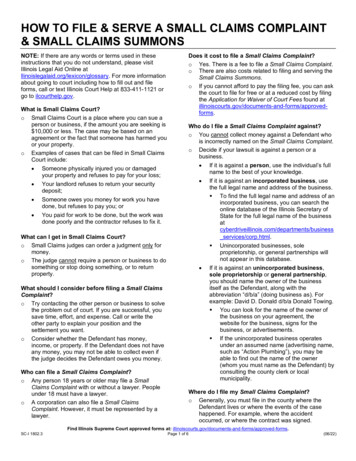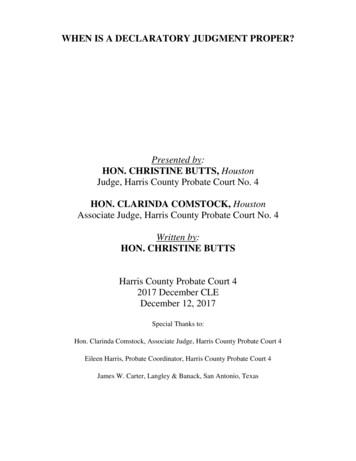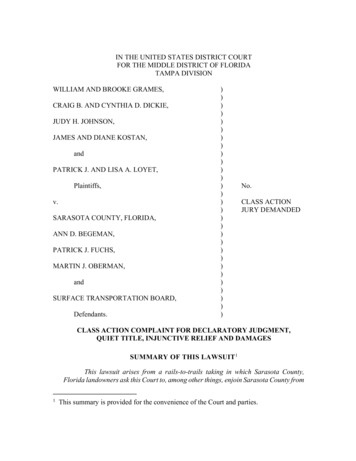
Transcription
IN THE UNITED STATES DISTRICT COURTFOR THE MIDDLE DISTRICT OF FLORIDATAMPA DIVISIONWILLIAM AND BROOKE GRAMES,CRAIG B. AND CYNTHIA D. DICKIE,JUDY H. JOHNSON,JAMES AND DIANE KOSTAN,andPATRICK J. AND LISA A. LOYET,Plaintiffs,v.SARASOTA COUNTY, FLORIDA,ANN D. BEGEMAN,PATRICK J. FUCHS,MARTIN J. OBERMAN,andSURFACE TRANSPORTATION LASS ACTIONJURY DEMANDEDCLASS ACTION COMPLAINT FOR DECLARATORY JUDGMENT,QUIET TITLE, INJUNCTIVE RELIEF AND DAMAGESSUMMARY OF THIS LAWSUIT1This lawsuit arises from a rails-to-trails taking in which Sarasota County,Florida landowners ask this Court to, among other things, enjoin Sarasota County from1This summary is provided for the convenience of the Court and parties.
removing or demolishing these owners’ private property in order to build a publicrecreational trail until the legitimacy of Sarasota County’s and the federalgovernment’s taking is established and until these owners are justly compensated forthat property taken from them. This lawsuit is brought under both the Fifth Amendmentto the United States Constitution and Article X, Sec. 6 of the Constitution of the Stateof Florida.The federal government took these owners’ land for the northern extension ofthe Legacy Trail between Sarasota and Venice. The Legacy Trail is a publicrecreational trail and a rail-trail corridor easement the federal government“railbanked” under the National Trails System Act.2In the early 1900s, these landowners’ predecessors-in-title granted SeaboardAir Line Railway a right-of-way easement allowing the railroad to use a strip of theirland to build and operate a railway line between Sarasota and Venice. When theSeaboard and its successor railroads no longer operated, the original easementterminated, and the present-day owners held unencumbered title and the exclusive rightto possess and use their land and to exclude others from their property.The Seaboard Air Line Railway went bankrupt. The railroad right-of-wayultimately went to CSX Transportation (CSXT) which leased the right-of-way toSeminole Gulf Railway (Seminole Gulf). By 2002, CSXT and Seminole Gulf no longeroperated a railroad across this strip of land. In 2019, CSXT and Seminole Gulfpetitioned the federal Surface Transportation Board (the Board) for authority toabandon the railroad right-of-way. The Board granted the railroad permission toabandon this railway line.Under Florida property law and the terms of the original easement, the railroadright-of-way easement terminated, and the present-day landowners heldunencumbered title to their land and enjoyed the exclusive right to use and possess2The National Trails System Act of 1968 (as amended 1983), codified at 16 U.S.C. § 1241,et seq.-2-
their land.3 In short, CSXT and Seminole Gulf had no right to sell or transfer aneasement across these owners’ land to anyone.4But the federal government wanted the land under otherwise-abandonedrailroad right-of-way easements to be used for public recreation and wanted to retainjurisdiction over these owners’ land so the Board could authorize a new federal carrierto build a new public transportation corridor across the land in the future. To achievethis objective Congress amended the National Trails System Act adding section 8(d)5which authorized the federal government to take owners’ “reversionary” interests inland and allow a non-railroad to use the owners’ private property for public recreation(such as a trail) until the federal government authorizes a new railroad to build arailway across these owners’ land.6 The federal government and Sarasota County are4Chief Justice Roberts explained that when a railroad no longer uses its right-of-way, theowner of the fee estate regains unencumbered title and possession of their land:The essential features of easements—including, most important here, whathappens when they cease to be used—are well settled as a matter of property law.An easement is a “nonpossessory right to enter and use land in the possession ofanother and obligates the possessor not to interfere with the uses authorized bythe easement.” “Unlike most possessory estates, easements . may be unilaterallyterminated by abandonment, leaving the servient owner with a possessory estateunencumbered by the servitude.” In other words, if the beneficiary of theeasement abandons it, the easement disappears, and the landowner resumes hisfull and unencumbered interest in the land.Marvin M. Brandt Rev. Tr. v. United States, 572 U.S. at 104-05 (2014) (quoting Restatement(Third) of Property).4See Preseault v. Interstate Commerce Commission, 494 U.S. 1 (1990) (Preseault I) and theAlabama Supreme Court’s recent decision in Monroe Cnty. Comm’n v. A.A. Nettles, Sr. Props.,No. 1170738, 2019 Ala. LEXIS 37, at *1 (Apr. 26, 2019) .5Codified at 16 U.S.C. §1247(d).6We use the term “reversionary” as a shorthand description of the owner of the fee estate’sinterest. This is not technically correct, since nothing “reverts,” but it is frequently used bycourts to describe how landowners regain their full possessory interest in the property that wasonce burdened by the railroad easement. The owner of the fee estate continually possesses thefee estate. “There is an alternative way to describe property transactions involvingeasements. Instead of calling the property owner’s retained interest a fee simple burdened bythe easement, this alternative labels the property owner’s retained interest following thecreation of an easement as a ‘reversion’ in fee. Upon the termination, however achieved, ofthe easement, the ‘reversion’ is said to become fully possessory; it is sometimes loosely saidthat the estate ‘reverts’ to the owner.” Preseault v. United States, 100 F.3d 1525, 1533 (Fed.Cir. 1996) (Preseault II); see also Marvin M. Brandt Rev. Trust v. United States, 572 U.S. 93,-3-
taking private property for a new federal rail-trail corridor. In April 2004 the Boardissued an order invoking the federal Trails Act and took a right-of-way across privateland between Venice and Sawyer Loop Road. This was the subject of prior Trails Actlitigation. The government’s taking of property for this southern segment of the LegacyTrail was the subject of prior litigation. See Rogers v. United States, 90 Fed. Cl. 418(2009). See also McCann Holdings, Ltd. v. United States, 111 Fed. Cl. 608 (2013), andChilders v. United States, 116 Fed. Cl. 486 (2014).The federal government has paid the owners whose property was taken for thissouthern segment of the Legacy Trail. In December 2017 the Board issued an orderextending the Legacy Trail about one-and-one-half miles north of Sawyer Loop Road.The owners of the property taken for this extension sued the federal government seekingcompensation in Cheshire Hunt v. United States. The Board then issued another orderinvoking the Trails Act and taking more landowners’ private property to extend theLegacy Trail into downtown Sarasota from Ashton Road to Payne Park. The federalgovernment’s third order is the order that took these owners’ land and gave rise to thislawsuit.Sarasota County has demanded many of these owners to remove“encroachments” (such as pools, fences, sheds and other improvements) located withinthe newly-created federal easement. Sarasota County has not told the owners theauthority it has to make these demands.When any governmental entity takes private property, the United StatesConstitution requires the government pay the owner “just compensation” for theproperty the government has taken. 7 Additionally, if a taking is under color of statelaw, Florida’s constitution requires the government pay the owner “fullcompensation” to make the owner whole and put the owner in as good a position106, n.4 (2014), and Monroe County Comm’n v. Nettles, 2019 Ala. LEXIS 37 (April 26, 2019)(petition for certiorari pending).7The Fifth Amendment to the United States Constitution provides, “No person shallbe deprived of life, liberty, or property, without due process of law; nor shall private propertybe taken for public use, without just compensation.” Consider also Supreme Court JusticeHolmes’s decision in Pennsylvania Coal Co. v. Mahon, 260 U.S. 393, 416 (1922) (“We are indanger of forgetting that a strong public desire to improve the public condition is not enoughto warrant achieving the desire by a shorter cut than the constitutional way of paying for thechange.”), and the Supreme Court’s decision in Armstrong v. United States, 364 U.S. 40, 49(1960) (“The Fifth Amendment’s guarantee that private property shall not be taken for a publicuse without just compensation was designed to bar Government from forcing some peoplealone to bear public burdens which, in all fairness and justice, should be borne by the publicas a whole.”). These Fifth Amendment protections are applied against state and localgovernments through incorporation by the 14th Amendment.-4-
financially as he or she would have been if the property had not been taken.8 TheUnited States Supreme Court ruled that the federal government’s invocation of theTrails Act takes an owner’s private property, and the Just Compensation Clause of ourConstitution compels the federal government to pay the owner for that property thefederal government took. 9 The federal government must also reimburse the owner’slegal fees and litigation expenses and must pay the owner interest for the government’sdelay in paying the owners compensation. See Uniform Relocation Assistance andReal Property Acquisition Policies Act of 1970, 42 U.S.C. 4601 et seq. (URA).Sarasota County is similarly constrained by both the Fifth Amendment of theUnited States Constitution and by Article X, Sec. 6 of the Constitution of the State ofFlorida. If Sarasota County attempts to condemn private property through its powersof eminent domain, it must comply with Article X, Sec. 6 of the Constitution of the Stateof Florida, as implemented by Chapters 73 and 74 of the Florida Statutes. SarasotaCounty has not done this.Neither the federal government nor Sarasota County has paid (nor even offeredto pay) these landowners. The landowners have filed a lawsuit seeking compensationfrom the United States in the United States Court of Federal Claims. This FifthAmendment Takings Clause claim is brought under the Tucker Act (28 U.S.C. 1491)and is pending in the United States Court of Federal Claims. The Tucker Act does not,however, provide the Court of Federal Claims jurisdiction to issue declaratory orinjunctive relief. Nor does the Court of Federal Claims have jurisdiction to quiet titleunder 28 U.S.C. 2409a or award damages or order Sarasota County to compensatethese owners for any property Sarasota County claims to have taken in excess of the8Article X, Sec. 6 of the Constitution of the State of Florida provides that “No private propertyshall be taken except for public purpose with full compensation therefor paid to each owner . .” Under Florida law, the measure of “full compensation” is a constitutional entitlementwherein the theory and spirit of such guarantee requires the practical attempt to make the ownerwhole. Behm v. Division of Administration, Dept. of Transportation, 383 So.2d 216 (Fla.1980); Jacksonville Expressway Authority v. Henry G. Du Pree Co., 108 So.2d 289 (Fla. 1959),69 A.L.R.2d 1445. Such measure also includes payment of an owner’s attorneys’ fees andcosts. Dade County v. Brigham, 47 So2d 602 (Fla. 1950).9Preseault v. Interstate Commerce Comm’n, 494 U.S. 1 (1990) (Preseault I); Preseault v.United States, 100 F.3d 1525, 1533 (Fed. Cir. 1996) (Preseault II); Toews v. United States,376 F.3d 1371 (Fed. Cir. 2004); Caldwell v. United States, 391 F.3d 1226 (Fed. Cir. 2004);Barclay v. United States, 443 F.3d 1368 (2006); Illig v. United States, 274 Fed. Appx. 883(2008), cert. denied 557 U.S. 935 (2009); Ladd v. United States, 630 F.3d 1015, 1020 (Fed.Cir. 2010) (Ladd I), reh’g denied 646 F.3d 910 (Fed. Cir. 2011); Ladd v. United States, 713F.3d 648, 652 (Fed. Cir. 2013) (Ladd II); Navajo Nation v. United States, 631 F.3d 1268, 1275(Fed. Cir. 2011).-5-
property interest Sarasota County obtained by reason of the Board’s invocation of1247(d).Accordingly, we ask this Court to determine, among other things, the lawfulnessof Sarasota County’s actions and threatened actions, the lawfulness of SarasotaCounty’s definition of the taking by the federal government, to quiet title, to enjoinSarasota County from requiring landowners to remove or demolish existingimprovements on their land, to enjoin Sarasota County from removing or demolishingany improvement on any owner’s land until it is finally determined that it has theauthority to do so, and order Sarasota County to compensate owners for anythingSarasota County has taken. We also ask this Court to determine the respective interestin the right-of-way land held by the federal Surface Transportation Board, SarasotaCounty and each landowner.JURISDICTION AND VENUE1.This Court has subject matter jurisdiction pursuant to 28 U.S.C. 1331,1343(a)(4), 1346(f), and 1361. This action arises under the Constitution and laws of the UnitedStates as well as the Constitution and laws of the State of Florida.2.This action requests declaratory and injunctive relief under Sections 2201 and2202, and in accord with Federal Rules of Civil Procedure 57 and 65.3.These landowners seek a declaratory judgment and quiet title relief against thefederal government and Sarasota County arising from violations of the Constitution and lawsof the United States, as well as injunctive relief and damages against Sarasota County, Floridafor redress of federal and state law violations as provided by 42 U.S.C. 1983.4.Federal law grants this Court supplemental jurisdiction under 28 U.S.C. 1367to issue an order granting these owners relief under state law. The owners’ state law claimsagainst Sarasota County include Fla. Const. Art. X, § 6, as implemented by Chapters 73 and74 of the Florida Statutes and the owners’ federal rights include those rights guaranteed by the-6-
Fifth Amendment to the Constitution and federal law including the Fifth Amendment and theUniform Relocation Act.5.Venue is appropriate in this Court under 28 U.S.C. 1391(b), because asubstantial part of the events or omissions giving rise to the claims in this district, and becauseSarasota County is in this district.6.The landowners seek a declaration that defines the nature, scope and limits ofthe rail-trail corridor easement the federal Surface Transportation Board when the Boardinvoked section 8(d) of the federal Trails Act. This federal statute and the Board’s order alsodefines the nature and extent of Sarasota County’s rights as the trailuser to use these owners’land.7.The landowners have standing because injury they face is a constitutional civilrights violation visited upon them by the federal Surface Transportation Board and SarasotaCounty.THE GOVERNING LAW8.The following provisions of the United States Constitution, the United StatesCode and Florida law govern this dispute.a. The Fifth Amendment to the United States Constitutionprovides, “No person shall be deprived of life, liberty, or property,without due process of law; nor shall private property be taken forpublic use, without just compensation.” This provision applies to thefederal government directly and to all state and local governmentalentities through its incorporation into the 14th Amendment.Macdonald v. Cnty. of Yolo, 477 U.S. 340, 342 n.1 (1986).b. Section 8(d) of the National Trails System Act provides, “interimuse [of abandoned railroad right-of-way easements for publicrecreation] shall not be treated, for purposes of any law or rule oflaw, as an abandonment of the use of such rights-of-way for railroad-7-
purposes.” The Board’s invocation of section 8(d) imposes a newand different easement across the owners’ land. Preseault v.Interstate Commerce Comm’n, 494 U.S. 1 (1990) (Preseault I);Preseault v. United States, 100 F.3d 1525, 1533 (Fed. Cir. 1996)(Preseault II); Toews v. United States, 376 F.3d 1371 (Fed. Cir.2004); Trevarton v. South Dakota, 817 F.3d 1081, 1086-87 (8th Cir.2016).c. The Uniform Relocation Assistance and Real PropertyAcquisition Policies Act of 1970 (URA), 42 U.S.C. § 4654(c)requires the federal government to reimburse these owners the“reasonable costs, disbursements and expenses, includingreasonable attorney, appraisal and engineering fees, actuallyincurred because of [the] proceeding.” The URA also requires thefederal government or any state or municipal government usingfederal funds (such as Sarasota County) to guarantee the rightsafforded by the URA.d. Section 4622(a) of the Uniform Relocation Assistance Act (URA)provides the federal government must also pay other expenses andcosts an owner incurs including: “(1) actual reasonable expenses inmoving himself, his family, business, farm operation, or otherpersonal property; (2) actual direct losses of tangible personalproperty as a result of moving or discontinuing a business or farmoperation (3) actual reasonable expenses in searching for areplacement business or farm.”e. Section 4622(d) of the URA provides the federal government mustalso pay the costs of relocating “utility facilities” including: “(i) anyelectric, gas, water, steam power, or materials transmission ordistribution system; (ii) any transportation system; (iii) anycommunications system (including cable television); and (iv) anyfixtures, equipment, or other property associated with the operation,maintenance, or repair of any such system.”f. The Florida Constitution, including Fla. Const. Art. X, § 6, asimplemented by Chapters 73 and 74 of the Florida Statutes, whichstates that “[n]o private property shall be taken except for a publicpurpose and with full compensation therefor paid to each owner orsecured by deposit in the registry of the court and available to theowner.”g. The federal Quiet Title Act, 28 U.S.C. 2409a, provides in relevantpart that “[t]he United States may be named as a party defendant in-8-
a civil action under this section to adjudicate a disputed title to realproperty in which the United States claims an interest . . .”h. 28 U.S.C. 2201, provides “any court of the United States, upon thefiling of an appropriate pleading, may declare the rights and otherlegal relations of any interested party seeking such declaration,whether or not further relief is or could be sought.”i. Rule 23 of the Federal Rules of Civil Procedure, provides forclass action lawsuits, stating that “[o]ne or more members of a classmay sue . . . as representative parties on behalf of all members” ifnumerosity, commonality, typicality and adequacy requirements aremet.j. 42 U.S.C. 1983, provides individuals the right to sue governmentsand their employees and others acting “under color of state law” forcivil rights violations. This federal law grants these owners the rightto sue Sarasota County.k. The Civil Rights Attorney Fee Act, 42 U.S.C. 1988, grants thiscourt authority to order Sarasota County to reimburse these owners’reasonable legal fees and litigation expenses.BACKGROUNDA.The railroad right-of-way easement between Sarasota and Venice.9.In the early 1900s, much of the land in what is now Sarasota County, Floridawas owned by Bertha Palmer and members of her family, including her son Adrian Honore.10The Palmer family was from Chicago and Bertha Palmer’s husband, Potter Palmer, foundedthe retail chain that became Marshall Fields. After his death and the Chicago Fire, BerthaPalmer came to Sarasota, Florida. At the time Sarasota was turpentine farms and fishingvillages. Bertha Palmer and her family wanted to develop and promote Sarasota as a touristdestination for residents from Chicago and other northern locations to escape cold winters.10What is now Sarasota County was originally part of Manatee County.-9-
10.To facilitate development of Sarasota and Venice, the Palmer family wantedthe Seaboard Air Line Railway to build a railroad line between Sarasota and Venice. At thetime, there was no interstate highway system and there were no airlines; the only way to bringresidents from northern cities like Chicago to Florida was by railroad.11.In November 1910 Adrian Honore, the predecessor-in-interest to these present-day landowners, granted Seaboard a right-of-way easement across his land allowing Seaboardto build and operate a railway line from Sarasota to Venice. A copy of the right-of-wayeasement Adrian Honore granted Seaboard Air Line Railway is attached as Exhibit 1.Honore’s easement provided, “if at any time [following the construction of the railroad] thesaid [railroad] shall abandon said land for railroad purposes [,] the above described pieces andparcels of land shall ipso facto revert to and again become the property of the undersigned, hisheirs, administrators and assigns.” See also Rogers v. United States, 90 Fed. Cl. 418, 430-31(2009) (“the Honore conveyance placed an explicit limitation on the use of the property interestconveyed and contained an unequivocal stipulation that title would revert to the grantor upondiscontinuance of the use of the parcel for its intended railroad purpose.”). Other landownersgranted similar railroad right-of-way easements to Seaboard Air Line Railway.12.Not long after Adrian Honore granted Seaboard an easement across his land,the newly-created federal Interstate Commerce Commission inventoried railroad companies’assets and mapped railway lines. These federally-created maps are called “Valuation Maps.”1111See Valuation Act of 1913, 37 Stat. 701, ch. 92 (March 1, 1913). The Valuation Maps arenot land title records and are not recorded in the state land title office. But these “Val Maps”do provide a helpful survey of the property interest in railroad corridors.- 10 -
The valuation maps and accompanying schedules are now kept by the National Archives andRecords Administration.13.Adrian Honore and the other landowners granted the Seaboard Railway only aright-of-way easement to operate a railroad across the strip of land. Under the explicit termsof the original easement and Florida law, when Seaboard or its successor railroad no longeroperated trains across this strip of land, the easement terminated and these landowners heldunencumbered title to the land and enjoyed the exclusive right to use and possess the land andto exclude others from their land. Chief Justice Roberts explained in Brandt Trust v. UnitedStates, 572 U.S.93, 105 (2014) that “[w]hen the [railroad] abandoned the right of way , theeasement terminated. [The owner’s] land become[s] unburdened of the easement,conferring on him the same full rights over the [right-of-way land] as he enjoy[s] over the restof [his land].”14.The Supreme Court also held that the right to exclude others from an owner’sland is an essential feature of private property. Nollan v. California Coastal Comm’n, 483U.S. 825, 831 (1987) (“We have repeatedly held that, as to property reserved by its owner forprivate use, ‘the right to exclude [others is] “one of the most essential sticks in the bundle ofrights that are commonly characterized as property.”’”) (quoting Loretto v. TeleprompterManhattan CATV Corp., 458 U.S. 419, 433 (1982) and Kaiser Aetna v. United States, 444 U.S.164, 176 (1979)); Leo Sheep Co. v. United States, 440 U.S. 668, 685 (1979) (landowner “isentitled to the complete and exclusive enjoyment of [land]” and courts are “unwilling to upsetsettled expectations to accommodate some ill-defined power to construct public thoroughfareswithout compensation”) see also Knick v. Twp. of Scott, 139 S. Ct. 2162, 2170 (2019) (the- 11 -
Supreme Court has “long recognized that property owners may bring Fifth Amendment claims. . . as soon as their property has been taken.”).B.Seaboard’s successor railroads abandoned the railroad right-of-way andthe original easement terminated.15.The Seaboard Railway did not survive but went through a series ofbankruptcies, and Seaboard’s assets (including its interest in the Sarasota-to-Venice right-ofway easement) wound up in the hands of successor railroads. The right-of-way easementAdrian Honore originally granted Seaboard was ultimately transferred to CSX Transportation,Inc. (CSXT) which, in turn, leased the railway line to Seminole Gulf Railway, L.P. (SeminoleGulf).16.By 2002, CSXT and Seminole Gulf no longer operated a railroad over this landand neither Seminole Gulf nor CSXT had any need for this right-of-way nor did Seminole Gulfor CSXT intend to operate a railroad across this land now or in the indefinite future.17.In March 2019, Seminole Gulf requested the Surface Transportation Board toallow it to abandon a 7.68-mile segment of rail line between milepost 890.29 on the north sideof Ashton Road and milepost SW 884.70, and between milepost 930.30 and milepost 928.21on the north side of State Highway 780 (Fruitville Road). See Exhibit 2 AbandonmentPetition, STB Docket No. AB-400 (Sub-No. 7X) (March 8, 2019).18.Seminole Gulf told the Board that “No local or overhead traffic has moved overthe Subject Line since prior to 2007, a period of more than ten years.” Notice of ExemptAbandonment, STB Docket No. AB 400 (Sub No. 7X) (March 8, 2019), p. 3. Seminole Gulf’sstatements to the Board are made under penalty of perjury.- 12 -
19.Seminole Gulf and CSXT had previously made similar representations to theBoard concerning the southern segments of the right-of-way between Sarasota and Venice.20.After the railroads told the Board that they (Seminole Gulf and CSXT) wantedto abandon the railway line, Sarasota County (which is not a railroad) asked the Board toinvoke section 8(d) of the Trails Act and authorize Seminole Gulf and CSXT to transfer theotherwise abandoned right-of-way to Sarasota County so that Sarasota County could build apublic recreational trail across these owners’ land. See Exhibit 3 (STB Docket No. AB 400(Sub No. 7X)).21.Seminole Gulf and CSXT had no right to transfer or sell any interest in theseowners’ land to Sarasota County. A railroad can only transfer its interest to another railroadand has no interest it can transfer to a non-railroad. See E. Alabama Ry. Co. v. Doe, 114 U.S.340, 354 (1885); see also Monroe Cnty. Comm’n v. A.A. Nettles, Sr. Props., No. 1170738,2019 Ala. LEXIS 37, at *14 (Apr. 26, 2019) (deed from railroad “conveyed nothing to theCommission because the railroad, at the time of conveyance, had nothing to transfer. In otherwords, the railroad’s inaction in failing to use its right-of-way terminated the right-way-of,divesting it of any further interest in the property.”), cert. denied, 2020 U.S. LEXIS 203(U.S. Jan. 13, 2020).22.Last May (in 2019) the federal Surface Transportation Board issued an ordercalled a Notice of Interim Trail Use or Abandonment (NITU) invoking section 8(d) of theTrails Act. See Exhibit 4. The Board’s order provided that “Use of the right-of-way for trailpurposes is subject to possible future reconstruction and reactivation of the right-of-way forrail service” governed by the Board’s jurisdiction. Id. at 2.- 13 -
23.Were it not for the Board’s invocation of section 8(d) of the federal Trails Act,Seminole Gulf and CSXT had no interest in the land under the former railway line and hadnothing they could sell or transfer to Sarasota County, the Public Trust for Land or anyoneelse. See Brandt Trust, E. Alabama Ry. Co., Monroe Cnty. Comm’n, and Leo Sheep, supra.24.This same Seaboard railroad right-of-way was the subject of the prior TrailsAct litigation involving the southern section of the Legacy Trail. See Rogers v. United States,90 Fed. Cl. 418 (2009); Childers v. United States, 116 Fed. Cl. 486, 497 (2014) and McCannHoldings v. United States, 111 Fed. Cl. 608, 614 (2013). The litigation over the southernsegments of the right-of-way involved an earlier April 2004 order of the Board invokingsection 8(d) to take a twelve and one-half mile-long segment of the Sarasota-to-Venice LegacyTrail corridor south of the segment that is the subject of this litigation.25.The first segment of the Legacy Trail, the southern segment runs from Veniceto the Culverhouse Nature Park just south of Sawyer Loop Road. The owners of the land takenfor this southern segment sued the federal government and were paid in the Rogers, McCannand Childers litigation presided over by Judge Williams of the Court of Federal Claims. Thesecond segment extends north of the Culverhouse Park to Ashton Road. The owners of landtaken for the second segment of Legacy Trail are parties in Cheshire Hunt v. United States.Judge Wheeler is hearing these owners’ claims. The land taken for the northern extension ofthe Legacy Trail – which is the subject of this litigation – runs about six miles north of AshtonRoad to Fruitville Road. The owners of land taken for this northern extension include thoseowners in the 4023 Sawyer Road I, LLC v. United States which was originally assigned toJudge Williams but has now been transferred to Judge Wheeler.- 14 -
26.An important point which Plaintiffs will revisit below is the limited jurisdictionof the Court of Federal Claims. That court has no jurisdiction over Sarasota County and has noauthority to enter injunctions or declaratory relief or to decide a federal quiet title action. TheCourt of Federal Claims is not an Article III court and its jurisdiction is limited to determiningand awarding money damages. Petro-Hunt, L.L.C. v. United States, 126 Fed. Cl. 367, 382(2016); Caldwell v. United States, No. 16-357C, 2016 U.S. Claims LEXIS 238, at *19 (Fed.Cl. Mar. 25, 2016).27.In apparent reliance upon the Board’s order invoking Section 8(d), SarasotaCounty sent to almost 300 Sarasota County landowners letters claiming their existingimprovements (pools, septic fields, fences, sheds and other structures) “encroached” uponproperty Sarasota County claimed to own. Sarasota County also threatened to enter theseowners’ property, remove existing improvements such as swimming pools, fenc
CLASS ACTION COMPLAINT FOR DECLARATORY JUDGMENT, QUIET TITLE, INJUNCTIVE RELIEF AND DAMAGES SUMMARY OF THIS LAWSUIT1 This lawsuit arises from a rails-to-trails taking in which Sarasota County, Florida landowners ask this Court to, among other things, enjoin Sarasota County from 1 This summary is provided for the convenience of the Court and parties
